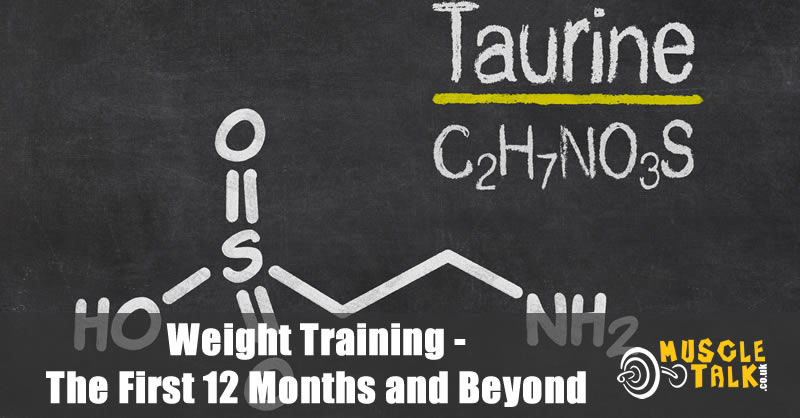Taurine is an amino acid which recently is getting considerable attention as a sports, bodybuilding and health supplement. Taurine has also been shown in supplemental doses to have a number of other possible positive benefits in some people; the most common application you’ll have seen is its use in sports and stimulant drinks such as pre-workout supplements.

The real name for taurine is 2-aminoethanesulfonic acid and it is a derivative of the sulpher containing amino acid cysteine. It is not one of the 20 principle protein synthesizing amino acids, indeed it is questionable if it is an amino acid at all in biochemistry terms as strictly speaking it lacks a carboxyl group. However it does contain a sulphonate group and, as it is found in polypeptide (protein) chains (it is derived from cysteine after the protein has been formed), it is accepted in scientific literature as an amino acid.
In humans it has a notable role in many functions, these include: it is a constituent of bile, it is involved in calcium homeostasis, it helps membrane stabilization, and many more. More notably it is a conditionally essential amino acid in prematurely born infants as many lack the enzymes needed to convert cystathione to cysteine, hence taurine deficiency is common. For this reason it is added to many special care infant formulas as a measure of prudence.
There is also evidence that taurine in adult humans may help reduce blood pressure (Militante & Lombardini 2002), and recent studies show that taurine supplements taken by rats on a high-fat diet prevented them from becoming overweight and improved diabetes control (Li et al 2006), but studies have yet to be done on the effect of taurine on obesity in humans.
It’s most well known supplemental application is its use alongside or instead of caffeine in ‘energy’ or ‘stimulant’ drinks. Many of the leading ‘stimulant drinks’ contain about one gram of taurine, however despite its presence in these drinks, taurine has not been shown to be energy-giving per se, however the results of the studies into taurine usage have shown that taurine is involved in reducing muscular fatigue (Warskulat et al 2004) and has benefits to thermoregulation (taurine helps stabilise body temperature in physical activity) and concentration.
It is often incorrectly claimed therefore to be a ‘stimulant’, indeed it may actually be involved in inhibiting excitary neurones in the brain (like GABA does), making it more of a relaxant (Faseb 2004). Its use in stimulant drinks therefore is optimal alongside a stimulant like caffeine, for its benefits in reducing fatigue, increasing exercise capacity, aiding thermoregulation and in improving concentration.
Taurine also has other possible benefits as a supplement. It acts as a cell volumiser, in a similar way to creatine. This means it helps draw water from around the muscle into the muscle to help it feel and look fuller. Because it is a cell volumiser, taurine is held within the muscle so it may also be of benefit for those of you who suffer with muscle cramps. Here taurine’s role in calcium homeostasis comes into play; it affects calcium ions within in the cell which in turn has effects on electrolyte regulation.
You’ll see taurine as an ingredient in a wide array of sports supplements ranging from stimulant drinks, to protein supplements and creatine formulas. Stick to 1-3grams 30 minutes before a hard exercise session, and this dose may be generally associated with a maximum of about 100mg of caffeine.
For those of you with a further interest in taurine, it is infact an essential nutrient for cat health, as cats cannot synthesize it. The absence of taurine causes a cat’s retina to slowly degenerate, causing central retinal degeneration (CRD) which manifests initially as minor eye problems and may lead on to irreversible blindness. In addition, taurine deficiency can cause feline dilated cardiomyopathy. All dry and wet cat foods now should contain a minimum of 0.1% taurine.
References
- Faseb J. (2004). Taurine prevents the neurotoxicity of beta-amyloid and glutamate receptor agonists: activation of GABA receptors and possible implications for Alzheimer’s disease and other neurological disorders. 18(3):511-8.
- Li F, Abatan OI, Kim H, Burnett D, Larkin D, Obrosova IG, Stevens MJ (2006). Taurine reverses neurological and neurovascular deficits in Zucker diabetic fatty rats. Neurobiology of Disease 22 (3).
- Militante, J. D.; J. B. Lombardini (2002). Treatment of hypertension with oral taurine: experimental and clinical studies. Amino Acids 23 (4): 381–393.
- Warskulat U, U. Flogel, C. Jacoby, H. Hartwig, M. Thewissen, M. W. Merx, A. Molojavyi, B. Heller-Stilb, J. Schrader and D. Haussinger (2004). Taurine transporter knockout depletes muscle taurine levels and results in severe skeletal muscle impairment but leaves cardiac function uncompromised.
